Frizzle Sizzle (Albuca Spiralis) Grow & Care Guide
Written by Iris
Nov 03 2021
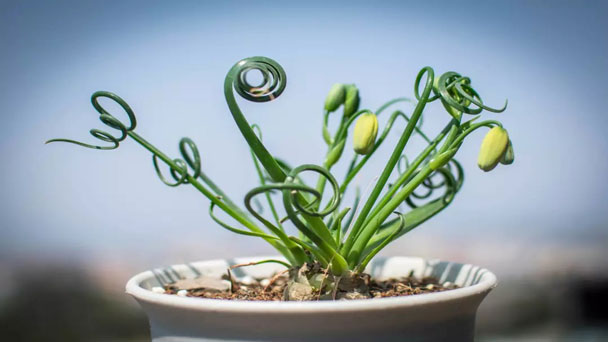
Frizzle Sizzle (Albuca Spiralis) is a common potted ornamental plant. It can also be used as the front of the flower bed or as a flower arrangement and illustration. It is a common small and medium-sized family potted plant. It is mostly used to beautify the home and decorate the interior. It can be placed on the desk and desk to refresh people at work, or placed on the balcony of the living room to make the home full of vitality.
Furthermore, its attractive spiral leaves are greatly affected by the amount of water and sunlight they receive. Put simply, low light conditions will produce fewer curls in the leaves.
Direct sunlight or extremely hot temperatures can burn your little plant. For this reason, make sure to place your frizzle sizzle in a position with filtered sunlight.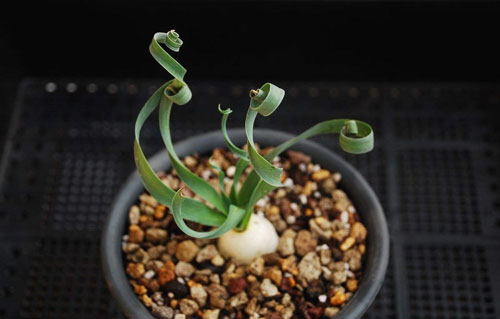
If you want to propagate with seeds, they will grow best between the autumn and winter months.
Plant the seeds in moist soil made of perlite and peat and cover them with a plastic bag for retention.
Seeds will germinate in about a week after planting. Sow the seeds and prepare them for growth for the same time when albuca Spiralis comes out of its dormancy.
Keep Albuca Spiralis in clay pots for better growth. These also have great irrigation built into the clay pot itself. You won't need to worry about repotting until about the three-year mark.
The pot-bound roots during the first 1-3 years provide plenty of stimulation for blooming periods.
At the end of the second year of summer (getting ready to go into the third winter), repot the flower into the next pot size up. Each time you repot Albuca Spiralis, you only need to go up one level in size.
Below is a summary of the step-by-step process to propagate Albuca Spiralis.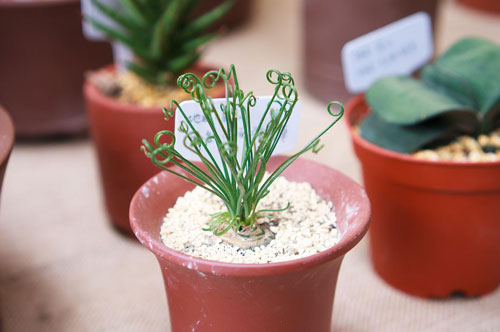
For container-grown plants, consider putting them in a south-facing window or other location where they’re guaranteed to receive lots of natural sunlight. Turn the plant a quarter-turn every day to ensure that the leaves don’t all point towards the sunlight.
These plants also prefer low to moderate humidity. High humidity can cause the leaves to lose their turgidity and become soft (5,7).
A balanced liquid fertilizer is best for your plant. Water your plant well the day before you fertilize to ensure it's already fully hydrated. Then, apply the liquid fertilizer to the soil, not to the albuca itself. Let any excess drain through the soil.
Fertilize once at the very beginning of the growing season, with a second dose if it needs it a few weeks later. If you're using a weak organic fertilizer, fertilize monthly during its growth spurt, but if you're using anything 2-2-2 or above, stick with just one to two doses early on. Fertilize again when you first start to see evidence of flower stalks developing. Do not fertilize in the summer or early fall.
Outside of that, leaves that have been in full sun may have developed a bit of sunburn. Remove those. In the summertime, it's also possible that your plant may have leaves go yellow during dormancy, and you'll want to trim off those yellow leaves too. Use a good pair of pruning snips to make a clean cut.
However, it's important to mention here that when albuca spiralis grows its flower stalks in the blooming season, it turns the tips of the curly leaves to brown. To prevent this, remove the flowers as soon as they start to grow.
Also, if you see its green leaves drying up and shedding, don't worry. It signifies that the dormancy period of frizzle sizzle has begun. The plant goes into dormancy during summer, loses all its leaves, and stays dormant until the winter. However, as long as the bulb is healthy, the leaves grow back in winter.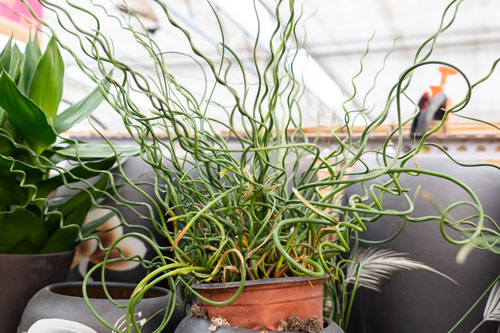
Some Albuca Spiralis will stop curling when the flower blooms, while some of them continue to curl. Each season could change for the same plant.
The Albuca Spiralis may have a season that blooms, and the leaves stay curled, while another season it blooms, and the leaves lose the curl.
Although this may happen randomly each season or not, if the leaves do straighten, there isn't a way to make them curl again for that period.
The best plan of action to encourage possible curling of the leaves the next time is to allow it to enter its dormant state.
To help the dormancy of Albuca Spiralis, don't water it during the summer at all. The leaves will die and remain with the bulb.
Don't worry; the plant isn't dying. It's just the beginning of the hibernation period. Next blooming season, new leaves will grow, and a fresh start for the leaves to curl begins.
Alternatively, you can stop all risk of losing the curls of the leaves by trimming the flower bud as it grows.
If you don't want the browning tips to steal the limelight of the plant, they are easy to trim off with your fingers.
While this is a common occurrence, it may accelerate by a lack of proper watering. Maintaining once a week, depending on the dryness of the soil, will help stop the acceleration.
As the plant focuses on growth, the tips will turn brown using all its nutrients.
Proper fertilizer and removing the stalks the bulbs sit on as they begin to grow will stop the browning from occurring.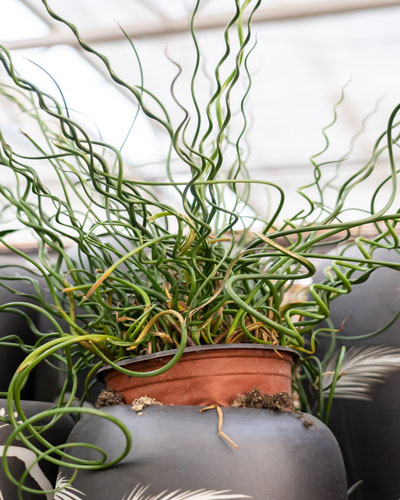
Where to Grow Frizzle Sizzle (Albuca Spiralis)How to Grow Frizzle Sizzle (Albuca Spiralis)Frizzle Sizzle Propagation with SeedsFrizzle Sizzle Propagation with Stem CuttingsFrizzle Sizzle Propagation with OffsetsHow to Care for Frizzle Sizzle (Albuca Spiralis)Frizzle Sizzle Lighting RequirementsFrizzle Sizzle Soil CareFrizzle Sizzle WateringFrizzle Sizzle Temperature & HumidityFrizzle Sizzle FertilizerFrizzle Sizzle PruningFrizzle Sizzle Pests & Diseases CareFrizzle Sizzle (Albuca Spiralis) FAQWhy Is My Albuca Spiralis Not Curling?Why Are the Tips of My Frizzle Sizzle Turning Brown?
Where to Grow Frizzle Sizzle (Albuca Spiralis)
Place your frizzle sizzle under the full sun or partly shady place in a south-facing direction. Don’t forget that this unusual yet attractive mini frizzle sizzle requires a sheltered spot, away from the radiators, draughts, and windows. Well, filtered sunlight for your albuca spiralis is acceptable.Furthermore, its attractive spiral leaves are greatly affected by the amount of water and sunlight they receive. Put simply, low light conditions will produce fewer curls in the leaves.
Direct sunlight or extremely hot temperatures can burn your little plant. For this reason, make sure to place your frizzle sizzle in a position with filtered sunlight.

How to Grow Frizzle Sizzle (Albuca Spiralis)
Frizzle Sizzle Propagation with Seeds
A common way you can propagate Albuca Spiralis is with the seeds.If you want to propagate with seeds, they will grow best between the autumn and winter months.
Plant the seeds in moist soil made of perlite and peat and cover them with a plastic bag for retention.
Seeds will germinate in about a week after planting. Sow the seeds and prepare them for growth for the same time when albuca Spiralis comes out of its dormancy.
Keep Albuca Spiralis in clay pots for better growth. These also have great irrigation built into the clay pot itself. You won't need to worry about repotting until about the three-year mark.
The pot-bound roots during the first 1-3 years provide plenty of stimulation for blooming periods.
At the end of the second year of summer (getting ready to go into the third winter), repot the flower into the next pot size up. Each time you repot Albuca Spiralis, you only need to go up one level in size.
Below is a summary of the step-by-step process to propagate Albuca Spiralis.
- Split the offsets away from the parent plant to grow separately.
- The plant won’t always have offsets, so seeds are the primary way to propagate.
- The germination process starts one week after sowing.
- The perfect time to plant the seeds is when the parent plant begins resprouting.
- The quality of the seeds lasts about six months, so plant the seeds quickly.
- After planting, ensure the seeds are moist and in a warm location under indirect light.
Frizzle Sizzle Propagation with Stem Cuttings
When propagating Frizzle Sizzle from cuttings, cut a leaf from the mother plant carefully with a clean knife or scissors. Before replanting, wait for a few days to allow it to callous. Use well-draining soil for your new succulent plant. Don’t forget to water when the soil dries out.Frizzle Sizzle Propagation with Offsets
Frizzle Sizzle propagates from offsets. To be able to propagate from the mother plant, you might wait several years for the main plant to produce an offset. To start this process, use a sharp knife and remove an offset from the main plant. When you remove the offset, clean the extra soil from it. Before replanting, wait for a few days to allow it to callous. Use well-draining soil for your new succulent plant. Don't forget to water when the soil dries out.
How to Care for Frizzle Sizzle (Albuca Spiralis)
Frizzle Sizzle Lighting Requirements
The frizzle sizzle, Albuca spiralis, is accustomed to lots of light in its native range. Full sun is best, but partial sun may be alright as long as it gets it consistently. 5-7 hours is absolutely necessary, but more full sun is even better. Too little light will prevent the leaves from curling, and instead, they'll just become long and wavy. If you dot have a reliable light source inside the house, consider getting a grow light.For container-grown plants, consider putting them in a south-facing window or other location where they’re guaranteed to receive lots of natural sunlight. Turn the plant a quarter-turn every day to ensure that the leaves don’t all point towards the sunlight.
Frizzle Sizzle Soil Care
As with other succulents, use a succulent soil mix that drains well. A basic mix is 50% succulent soil and 50% perlite. You can also use other materials such as gravel and mulch to provide additional drainage. The important thing is that the soil drains readily and doesn't clump or take on a muddy consistency when watered.Frizzle Sizzle Watering
The Frizzle sizzle needs to keep the soil moist during the growing season, so when we grow and care for frizzle sizzle, give it plenty of water, but avoid standing water. If the Frizzle sizzle is dry for a long time, then the leaves on the Frizzle sizzle can turn yellow.Frizzle Sizzle Temperature & Humidity
Although they prefer colder temperatures, corkscrew albucas are not very frost hardy. The optimum temperature for best growth is 60 to 70oF but it might need to drop to colder temperatures in order to produce viable seeds. High temperatures can scorch the spiral leaves.These plants also prefer low to moderate humidity. High humidity can cause the leaves to lose their turgidity and become soft (5,7).
Frizzle Sizzle Fertilizer
It's best to fertilize at certain times of the year for your Albuca spiralis. Frizzle sizzle needs a good kick-start in the late fall as it starts to go into its active growing season. After that, a second fertilizing when its flower stalks start to form in the spring is ideal.A balanced liquid fertilizer is best for your plant. Water your plant well the day before you fertilize to ensure it's already fully hydrated. Then, apply the liquid fertilizer to the soil, not to the albuca itself. Let any excess drain through the soil.
Fertilize once at the very beginning of the growing season, with a second dose if it needs it a few weeks later. If you're using a weak organic fertilizer, fertilize monthly during its growth spurt, but if you're using anything 2-2-2 or above, stick with just one to two doses early on. Fertilize again when you first start to see evidence of flower stalks developing. Do not fertilize in the summer or early fall.
Frizzle Sizzle Pruning
One of the best things about albuca spiralis: frizzle sizzle doesn't need a lot of pruning. The major pruning you will need to do is to remove the flower stalks. You can wait until after the seeds have formed. If you’re not saving seed, remove them once the flowers fade. This can cause the plant to do a second round of flowering, although that's rare.Outside of that, leaves that have been in full sun may have developed a bit of sunburn. Remove those. In the summertime, it's also possible that your plant may have leaves go yellow during dormancy, and you'll want to trim off those yellow leaves too. Use a good pair of pruning snips to make a clean cut.
Frizzle Sizzle Pests & Diseases Care
While most of the plants, including succulents, often develop pests and diseases, frizzle sizzle or albuca spiralis never does. In other words, this spiral grass plant has no issues, such as disease problems or pests.However, it's important to mention here that when albuca spiralis grows its flower stalks in the blooming season, it turns the tips of the curly leaves to brown. To prevent this, remove the flowers as soon as they start to grow.
Also, if you see its green leaves drying up and shedding, don't worry. It signifies that the dormancy period of frizzle sizzle has begun. The plant goes into dormancy during summer, loses all its leaves, and stays dormant until the winter. However, as long as the bulb is healthy, the leaves grow back in winter.

Frizzle Sizzle (Albuca Spiralis) FAQ
Why Is My Albuca Spiralis Not Curling?
It can be disappointing to see the leaves not curling. One occurrence for Albuca Spiralis, not curling, is semi-random.Some Albuca Spiralis will stop curling when the flower blooms, while some of them continue to curl. Each season could change for the same plant.
The Albuca Spiralis may have a season that blooms, and the leaves stay curled, while another season it blooms, and the leaves lose the curl.
Although this may happen randomly each season or not, if the leaves do straighten, there isn't a way to make them curl again for that period.
The best plan of action to encourage possible curling of the leaves the next time is to allow it to enter its dormant state.
To help the dormancy of Albuca Spiralis, don't water it during the summer at all. The leaves will die and remain with the bulb.
Don't worry; the plant isn't dying. It's just the beginning of the hibernation period. Next blooming season, new leaves will grow, and a fresh start for the leaves to curl begins.
Alternatively, you can stop all risk of losing the curls of the leaves by trimming the flower bud as it grows.
Why Are the Tips of My Frizzle Sizzle Turning Brown?
The tops of Frizzle Sizzle turning brown is common. When the flowers start to come up the stalk, it causes the tips of the leaves to turn brown.If you don't want the browning tips to steal the limelight of the plant, they are easy to trim off with your fingers.
While this is a common occurrence, it may accelerate by a lack of proper watering. Maintaining once a week, depending on the dryness of the soil, will help stop the acceleration.
As the plant focuses on growth, the tips will turn brown using all its nutrients.
Proper fertilizer and removing the stalks the bulbs sit on as they begin to grow will stop the browning from occurring.

Latest Updated
- Benefits of Bugleweed - 7 Science-backed Health Benefits
- Bugleweed Dangers & Side Effects - Is It Poisonous?
- How to Plant Evergreen Trees - What You Should Know
- When to Plant Evergreens - Grow Guide for Evergreen Trees
- 12 Wonderful Evergreen Shrubs for Your Garden
- 12 Popular Evergreen Plants with Pictures for Beginners
- When And How To Prune A Lilac Bush Like a Pro
- How to Grow & Care for Lilac Vine (Hardenbergia Violacea)
- Japanese Lilac Tree (Syringa Reticulata) Care & Propagation Guide
- Shumard Oak Pros and Cons - What to Know
Popular Articles
- Winter maintenance of Antirrhinum Majus
- How to Grow Terminalia Mantaly Tree
- How to Grow and Care for Crossostephium Chinense
- How to grow Antirrhinum Majus in spring
- Peristeria Elata (Dove Orchid) Profile: Info & Care Guide
- Underwatered Snake Plant (Sansevieria Trifasciata) - Signs And How To Fix
- How to Care for Brazilian Jasmine Plant (Mandevilla Sanderi)
- How to Grow & Care for Graptopetalum Purple Delight in Summer
- Rosa Chinensis (China Rose): Plant Growing & Care Tips
- How to Care for Baby Sun Rose (Aptenia Cordifolia)